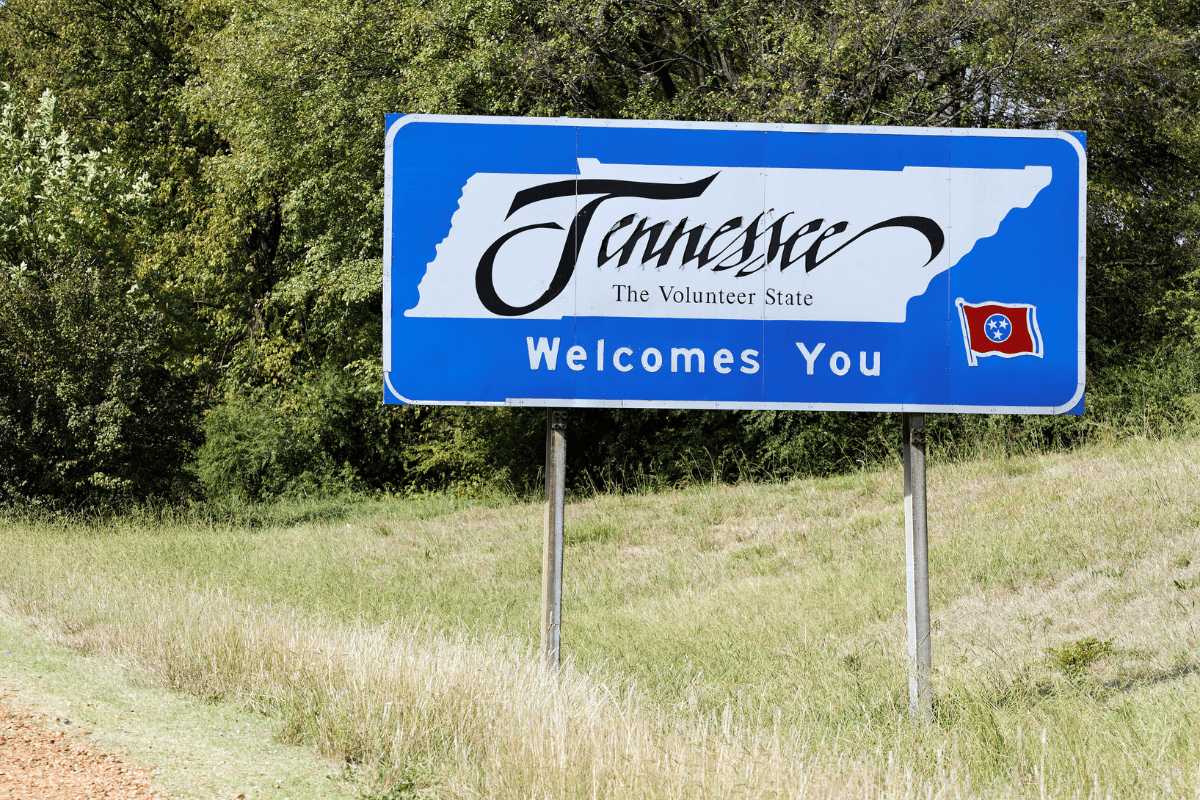Tennessee isn't just content with having a state bird and flower like everyone else. No, the Volunteer State has gone absolutely wild with official designations, racking up over 40 state symbols… more than any other state in the nation.
From a controversial flower war that lasted 54 years to becoming the first state to designate official books, Tennessee's collection of symbols tells the story of a state that takes its identity very seriously. And honestly? The stories behind these symbols are way more entertaining than you'd expect from government designations.
The musical madness: 15 state songs and counting
Let's start with the most Tennessee thing ever: the state has 15 official songs. That's not a typo. While most states are content with one anthem they play at boring government ceremonies, Tennessee has built an entire playlist.
The collection spans nearly a century, from "My Homeland, Tennessee" in 1925 to "Under a Tennessee Moon" in 2024. You've probably heard of "Tennessee Waltz," which became an international hit after its 1965 designation. And if you've ever been within 50 miles of a University of Tennessee sporting event, you definitely know "Rocky Top," even if the 1982 designation makes it technically optional at graduations (spoiler: it's never optional when the Vols are playing).
The songs get surprisingly spicy
Here's where it gets interesting. In 2022, Tennessee added Dolly Parton's "My Tennessee Mountain Home" because, well, it's Dolly. But then in 2023, they went rogue and designated Steve Earle's "Copperhead Road" as an official song. Yes, the one about moonshining and marijuana growing. The song has become so popular that road signs bearing its name are frequently stolen by fans.
The newest addition might be the most delightful: "Rockin' Around the Christmas Tree" became the official holiday song in 2024. Brenda Lee recorded it on Nashville's Music Row when she was just 13 years old in 1958, proving that Tennessee's musical genius starts young.
But wait, there's more. In 2003, the legislature went meta and designated songwriting itself as the official state art form. Because when you're the songwriting capital of the world, why not make it official?
Traditional symbols with Tennessee-sized drama
Every state needs the basics: a bird, a flower, and a tree. But Tennessee managed to turn even these simple designations into epic tales worthy of a country song.
The bird that sings everyone else's songs
The Northern Mockingbird became Tennessee's state bird on April 11, 1933, chosen through an election by the Tennessee Ornithological Society. It's actually perfect for Tennessee… this bird can mimic over 30 other species. Basically, it's the Nashville session musician of the bird world, able to play any tune you need.
The Great Flower War of 1919-1973
Now here's where things get juicy. In 1919, Tennessee schoolchildren democratically selected the passionflower as the state flower. Nice story, right? Democracy in action, kids learning civic engagement, everyone's happy.
Then in 1933, the legislature apparently developed collective amnesia and adopted the iris as the state flower, claiming Tennessee had never adopted a state flower. The passionflower supporters were not having it.
What followed was 54 years of what newspapers called the "War of the Iris and Passionflower." The Chattanooga News reported "bad blood" between the flower factions. Garden clubs took sides. Angry letters were written. It was basically the botanical equivalent of the Hatfields and McCoys.
Finally, in 1973, Senator Edward Blank solved the crisis with a compromise worthy of international diplomacy: the iris became the state cultivated flower, and the passionflower became the state wildflower. Peace returned to Tennessee's gardens, though some old-timers still grumble about it at garden shows.
The tree that's living a lie
The Tulip Poplar was designated in 1947, chosen because pioneers used it for everything from cabins to canoes. Here's the thing though… it's not actually a poplar. It's a magnolia. But after the whole flower debacle, nobody wanted to start another botanical controversy, so Tulip "Poplar" it remains.
Fun fact: It's North America's tallest hardwood and can reach 150 feet. That's like a 15-story building made of tree.
Wildlife symbols that actually make sense (mostly)
Tennessee's wildlife designations tell us a lot about what the state values: frontier legends, fishing, and apparently, insects.
The raccoon became the state wild animal in 1971, forever linking Tennessee to Davy Crockett and his coonskin cap. It's actually a solid choice… raccoons are clever, adaptable, and have those little hands that look like they're constantly plotting something. Very Tennessee.
The fish that holds a world record
In 2005, Tennessee replaced the largemouth bass with the smallmouth bass as the state sport fish. Tennessee is the only state that honors the smallmouth bass, and for good reason: Dale Hollow Lake produced the world record smallmouth at 11 pounds, 15 ounces in 1955. That record still stands today. Take that, every other state.
So. Many. Bugs.
Tennessee really went all-in on insects:
- Firefly (1975)
- Ladybug (also 1975)
- Honeybee as agricultural insect (1990)
- Zebra Swallowtail Butterfly (1995)
The butterfly was actually selected by a Gallatin High School biology class, proving that Tennessee students have more influence over state symbols than most legislators in other states.
Rock stars of the geology world
Tennessee's geological symbols might sound boring, but they're actually pretty cool once you dig into them (pun absolutely intended).
The pearl of the South
The freshwater pearl became Tennessee's state gem in 1979, honoring a pearl industry that operated from 1882 to 1914. The American Pearl Company in Camden is still the nation's only cultured freshwater pearl producer, making Tennessee a top 10 gemstone-producing state by value. Who knew?
Rocks that tell stories
Limestone became the state rock in 1979, which makes sense since it's everywhere in Tennessee. Its metamorphic form creates the famous Tennessee marble used in buildings across the country.
But the real star is agate, which was redesignated from rock to mineral in 2009 (apparently there was a classification crisis). Tennessee has its own special variety called "Paint Rock" agate with iron-stained patterns found nowhere else. It's like nature's version of tie-dye, but actually cool.
The fossil with a nickname
Tennessee's state fossil is Pterotrigonia thoracica, a 70-million-year-old Cretaceous bivalve that everyone just calls "Ptero." These well-preserved specimens from West Tennessee's Coon Creek Formation lived when T-Rex was stomping around. Imagine being a clam and missing the dinosaurs by hanging out in Tennessee. Classic Ptero.
Tennessee breaks new ground (because of course it does)
Not content with the usual symbols, Tennessee keeps inventing new categories. It's like that overachiever in school who wasn't satisfied with just getting A's.
America's first state books
In 2024, Tennessee became the first state to designate official state books. Not just one book, mind you, but 10 literary works including:
- The Aitken Bible (first English Bible printed in America)
- "All the King's Men" by Robert Penn Warren
- "Roots" by Alex Haley
- "Coat of Many Colors" by Dolly Parton
Because when Tennessee does something, it doesn't do it halfway.
The salamander that lives in darkness
The Tennessee Cave Salamander became the state amphibian in 1995. This little guy is found in only about 80 cave localities across Tennessee, Alabama, and Georgia. Tennessee is the only state with this endemic creature as its official amphibian, probably because no other state wanted to claim an animal that lives in complete darkness and has no eyes. But Tennessee saw potential where others saw a weird cave creature.
Cultural symbols that celebrate heritage
Tennessee's cultural symbols show that the state embraces both its American roots and immigrant influences… with style.
The most Tennessee fabric ever
The Tennessee tartan was adopted in 1999, designed by the state's Scottish societies. Each color has meaning:
- Natural white for unity
- Dark green for agriculture
- Purple for the iris
- Red for veterans' sacrifices
- Dark blue for Smoky Mountains
It's basically Tennessee's story woven into fabric. Highland Games participants across the state wear it with pride, probably while eating hot chicken.
Square dancing: Because pioneers needed fun too
Square dancing became the state folk dance in 1980. The designation recognizes it as a "uniquely attractive art form that remains a vibrant part of Tennessee folklore." More importantly, it provided crucial social connections for isolated pioneer families. Imagine being stuck on a remote farm in 1840s Tennessee… you'd definitely show up for square dancing night too.
The poem written in a prison cell
Here's where things get heavy. The state poem, "Oh Tennessee, My Tennessee," was composed by Admiral William Porter Lawrence in 1971 while he was a POW in North Vietnam. He wrote it during 60 days of solitary confinement after being shot down.
The poem expresses profound homesickness during extreme adversity. It's a reminder that state symbols aren't just fun government trivia… sometimes they represent real human experiences and sacrifice.
Conservation wins worth celebrating
Not all symbols are created equal. Some represent Tennessee's commitment to saving species from extinction.
The Tennessee Coneflower became a state wildflower in 2012, but its real story started much earlier. This purple beauty is found only within a 14-mile radius in Middle Tennessee's cedar glades. It was the second plant ever listed under the Endangered Species Act in 1979.
Here's the amazing part: through dedicated conservation efforts, it was successfully removed from the endangered list in 2011. That almost never happens. The Tennessee Coneflower went from nearly extinct to thriving, proving that sometimes government programs actually work.
Food, drinks, and agricultural pride
Tennessee's food and beverage symbols tell us what really matters: dairy, tomatoes, and regional cuisine.
Milk became the state beverage in 2009, when the industry was producing nearly 100 million pounds worth $202 million. That's a lot of milk mustaches.
The tomato serves as state fruit since 2003, which has sparked endless debates about whether tomatoes are fruits or vegetables. (They're fruits. Tennessee has spoken.) It's actually Tennessee's top fruit crop, so the designation makes agricultural sense.
But the real winner? Hot slaw became Tennessee's first official food in 2024. For those unfamiliar, hot slaw is a spicy coleslaw variant that goes on barbecue. It's divisive, distinctive, and definitely Tennessee.
The newest members of the symbol family
Tennessee keeps adding symbols like a collector who can't stop buying baseball cards.
Recent additions include:
- Bluetick Coonhound as state dog (2019)
- Eastern Red Cedar as state evergreen (2012)
- Prehistoric "Sandy" statue as state artifact (2014)
The "Sandy" statue was discovered in Wilson County and honors Tennessee's Native American heritage. Because even Tennessee's artifacts need to be dramatic archaeological discoveries.
Why Tennessee can't stop designating things
So why does Tennessee have more state symbols than anywhere else? Several factors come into play:
- Musical crossroads: When you're home to Nashville, Memphis, and Bristol (birthplace of country music), you need multiple songs
- Ecological diversity: From Appalachian peaks to Mississippi River bottomlands, Tennessee has a lot to represent
- Cultural melting pot: Native American, European, and African influences created a uniquely rich heritage
- Legislative enthusiasm: Tennessee lawmakers apparently never met a symbol they didn't like
- State pride: Tennesseans really, really love Tennessee
These symbols serve practical purposes beyond decoration. They appear in educational curricula, tourism promotion, and conservation efforts. From mockingbirds singing in state parks to "Rocky Top" thundering through Neyland Stadium, from limestone caves sheltering blind salamanders to Nashville's songwriters penning the next hit, Tennessee's symbols are living emblems of a state that celebrates its past while constantly evolving.
The next time someone mentions state symbols, you can casually drop that Tennessee has 15 state songs, fought a 54-year flower war, and was the first state to designate official books. Then watch their face as they process that information. Because in Tennessee, even the government designations have personality.





